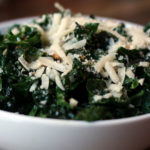Video: How To Make Healthy Kale
Kale is a dark, leafy green first cultivated over 2,000 years ago in the Mediterranean region, making its way to North America in the 1600s. Part of the brassica family, kale is a cruciferous vegetable and a relative of cabbage, collards and Brussels sprouts. Today kale is farmed in North America and throughout the world.
Why Is Kale Healthy?
Kale is an extraordinarily nutritious vegetable: eating it can increase your intake of fiber, vitamins (including C, the provitamin beta-carotene and folic acid), calcium and magnesium. It can also help reduce inflammation, lower cholesterol levels and protect the immune system. One cup of kale provides:
- Over 100 percent of the Daily Value (DV) of vitamin K, an essential nutrient that helps regulate normal blood clotting and may also be helpful for bone health.
- Over 100 percent of the DV of vitamin A, which is important for bone growth, immune system and reproductive health.
- Eighty-eight percent of the DV of vitamin C, a powerful antioxidant that helps to protect against heart disease, repairs and regenerates tissues, and may protect against some cancers by combating free radicals.
Kale is also a rich source of organosulfur compounds, which have been linked to cancer prevention. In addition, kale is very low on the glycemic index, making it a good choice for those following a low-glycemic diet.
What Are Different Types of Kale?
There are three general types of kale that are common in grocery stores today, and are often categorized by the leaf shape: flatter wide-leafed kale, narrow-leafed wrinkly kale, and tightly formed curly kale.
- Wide leafed kale is often called Siberian kale, and includes the Red Russian variety, and is often sweeter in taste than other types.
- Narrow-leafed kale is one of Dr. Weil’s favorites. Often called Lacinato-style kale, it includes Tuscan, Dinosaur and Toscano as part of its group. This flavorful type of kale does best with the ribs removed, as they tend to be tough.
- Curly kale (also called Scotch kale) has a peppery, pungent flavor.
Healthy Ways To Use Kale
Kale is fairly versatile, and can be eaten raw or cooked. In addition to the recipes below, kale can be added to soups, stews and stir-frys for nutritional value, flavor and texture; can be lightly sautéed or steamed with garlic as a side dish; and can be dehydrated and turned into kale chips – a healthy alternative to potato chips. Our Healthy Kale Video demonstrates how simple it is to prepare kale for use in a variety of ways!
Healthy Kale Recipes
If you want to expand your kale intake, try these recipes, each featuring kale:
How To Choose Kale
While it is available year-round, kale is at its peak from winter to the beginning of spring. When choosing kale, look for firm leaves and a moist stem, for the freshest taste. Avoid kale that is not refrigerated, as heat can affect its taste and texture, and kale that has small holes or yellowing leaves.
For a milder flavor, choose varieties of kale that have smaller leaves.
While kale is not currently on the Environmental Working Groups “Dirty Dozen” list, it does rank in the top 20, so choose kale that is organic when possible.
Video Transcript: How To Make Healthy Kale
- 1 Bunch Lacinato Kale, Ribs Removed And Torn
- 1 Lemon
- 1-2 Tablespoons Extra-Virgin Olive Oil
- 3-4 Teaspoon Sea Salt
- Cut Lemon In Half
- Squeeze Fresh Lemon Juice Over Kale
- Add Sea Salt
- Massage Kale For Several Minutes, Or Until Leaves Are Soft And Tender
- Add Olive Oil
- Give One More Quick Massage
- Enjoy Your Healthy Kale!













